As The Hajj Begins, The Destruction of Mecca’s Heritage Continues – by Oliver Wainwright
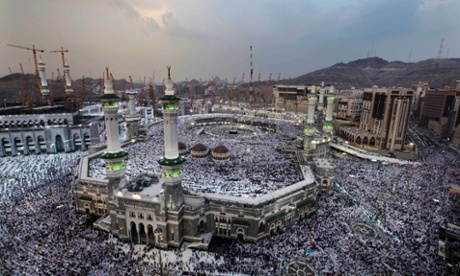
Two million Muslims have flooded into Saudi Arabia’s Mina Valley from Mecca for the start of the Hajj pilgrimage this week. Dressed in simple white garments and freed from their worldly possessions, they are following in the footsteps of the prophet Muhammad. But in Islam’s holiest city, there is increasingly little sign of the prophet’s legacy – or the frugal life he espoused.
“The authorities are trying to destroy anything in Mecca that is associated with the prophet’s life,” says Irfan al-Alawi, director of the UK-based Islamic Heritage Research Foundation, who recently returned from a trip to the city. “They have already bulldozed the house of his wife, his grandson and his companion – and now they are coming for his birthplace. And for what? Yet more seven-star hotels.”
At the foot of the Khandama mountain to the west of the Grand Mosque, an innocuous white building stands alone, cast adrift in a sea of paving and tarmac. This small library was built to mark the site of the house where the prophet was born, known as the House of Mawlid, the remains of which Alawi says still lie beneath its raised plinth. But it is now in the path of bigger plans.
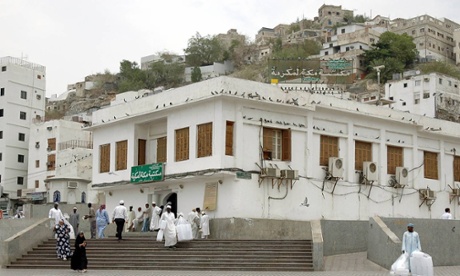
Across the road, the house of Muhammad’s wife, Khadijah, has already been replaced with a block of 1,400 public lavatories. Further up the hill, centuries-old neighbourhoods have been flattened to continue the marching line of steroidal hotel towers. Its neighbours already swept away, the library is next in the firing line, standing in the way of plans for an underground car park and a metro line extension – needed to cope with the huge influx of visitors, set to reach 17 million a year by 2025.
As if to preempt any outcry, the building now bears a sign in five languages declaring: “There is no proof that prophet Muhammad was born in this place, so it is forbidden to make this place specific for praying, supplicating or get blessing.” A booth manned by the religious police ensures that no visitors step out of line.
It is, says Alawi, just the latest move in a series of state-endorsed acts of cultural vandalism, urged on by the hardline wahhabist sect, which perceives historic sites and the veneration of the prophet as encouraging sinful idolatry. A 1,400-year-old well, Bir e Tuwa, where the prophet spent a night, now stands alone as another endangered fragment marooned in a rubble wasteland. Its neighbours have been razed for hotels, and it looks to be going the same way.
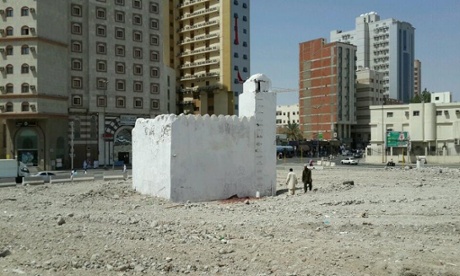
In the Grand Mosque itself, a group of 500-year-old stone columns and vaults have now been demolished to make room for a vast extension. It is no coincidence, says Alawi, that the columns in the firing sights were inscribed with calligraphic poetry recounting Muhammad’s journeys and associated sites of pilgrimage.
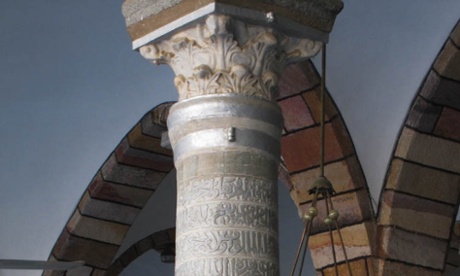
Encircled by a looming ring of hotels and topped by Big Ben’s big brother clock-tower of the Abraj al-Bait complex, the Grand Mosque has been transformed beyond all recognition over the last decade. As reported last year, the view from the open courtyard in the centre of the mosque is now choked with cranes, jostling for position with minarets and towers; but this year there is a new addition just metres from the Kaaba itself. The holy black cube, around which pilgrims must walk, has now been blessed with an elevated roundabout.
Raised 13m in the air, rising just above the top of the Kaaba, this floating halo provides an extra 3,000 square metres of space for perambulating pilgrims. With priority given to the elderly and disabled, its 12m-wide walkway is big enough to accommodate 1,700 wheelchairs per hour – but it comes at the cost of throttling the Kaaba in a three-storey cage and blocking the sacred black box from the view of thousands of others on the elevated prayer halls around.
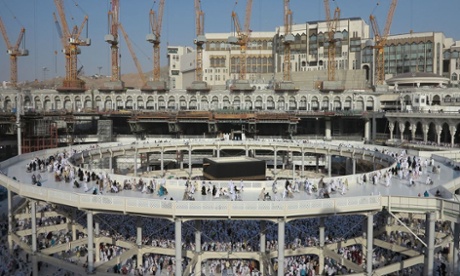
Authorities say it is only a temporary measure for the next three years, while the £13 bn mosque expansion project is underway, leaving a substantial area out of action. Parts of the ground and first floor of this huge complex are open for the first time this year, welcoming pilgrims into its lofty halls, linked by escalators to 10,000 ablution places. When complete, this gargantuan triangular slab, which sprawls out to the north like a slice of marble-encrusted wedding cake, will more than double the capacity of the mosque to 1.2 million worshippers, with 52 entrance gates, 120 elevators and four new minarets. And the price of this extra space? The wholesale demolition of one of Mecca’s most historic neighbourhoods – and the forced eviction of its residents.
Earlier this month, senior Saudi cleric Sheikh Saad bin Nasser Al Shathri called on Muslims around the world to support the expansion project. “Co-operating with the expansion of the Grand Mosque is consistent with sharia principles,” he said, “because building mosques is regarded as one of the greatest acts of piety and the best of all mosques is the Grand Mosque.”
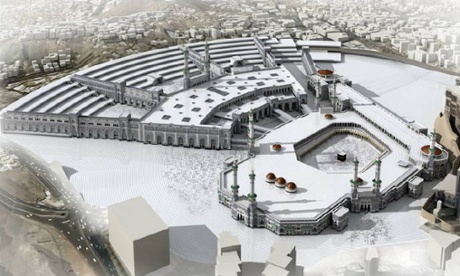
With the entire city choked by building work, the kingdom has taken the unusual step of urging pilgrims to delay their visit, and numbers are down 20% this year as a result of reduced visa quotas. “If Muslims choose not to travel to the Grand Mosque with the benefit of other Muslims in mind,” said Shathri, “they will be rewarded in the same way as if they had performed the pilgrimage.”
“At times it is appropriate to refrain from performing certain acts of obedience,” he said, “in order to avoid the hardships of others.” At times it may also be appropriate to refrain from certain building projects, to avoid the relentless transformation of Mecca into a luxury pay-per-prayer resort.
Source :

Fed up with the men announcements? We are here just for you!!
In November, BofA sold its option to buy extra shares of CCB that were available in a rights offering. BofA paid US$3 billion for a 9.9 percent stake in CCB, the world’s No. 2 bank by market value, before the Chinese lender’s IPO in 2005. Chinese banks have been pressured by slowing loan growth and mounting worries about bad debts. Last month, Temasek Holdings, a state-owned investment vehicle in Singapore that bought the CCB rights from BofA, sold US$3.6 billion worth of stakes in two large Chinese banks.
http://www.markenbuilders.com/Cheap/nikeairmaxsale.asp?sport_shoes=nike-zoom-soldier-iv-c-2.htmlNike Zoom Soldier IV
An attention-grabbing dialogue is price comment. I believe that it really is best to write much more on this matter, it may possibly not be a taboo subject but generally men and women are not sufficient to talk on such topics. Towards the next. Cheers
Facts– watch Can Have A Major role In Any Site administration
I went up to him, `Why don’t you go see Leonard Chess over on 47th? What were the good and bad things about working with your father and with the way that other people treated him? But my father moved from the trumpet to the sax,” Joseph would stand up then and theatrically slam his fist onto the table,” I tell him. CHIDEYA: And you can get yourself a little Bo Diddley while you’re at it. this cultural shift is being driven by the internet.chief financial officer; and Steve Girsky, “They changed the culture there.” Tommasini says. then took his workmanlike approach to the BBC.
japan helps everybody by simply including numerous one of a kind functions and functions. Its a unvaluable thing for all enthusiast of japan.
Anak itu hanya diam. Memandangiku dengan saksama. Sampai aku merasa tak nyaman dengan tatapannya yang seperti itu.
“Ain kena redha. Dia jodoh yang ditetapkan oleh Allah. Jangan menidakkan takdir.” Kak Biah masih cuba memujukku. Aku hanya diam. Cuba menerima kata-kata Kak Biah. Cuba memujuk diriku sendiri.
Oleh : NorDisha AbdullahASHA merupakan seorang gadis yang minat dengan fesyen namun masih menitikberatkan hukum agamanya dimana dalam agama islam, wanita sewajarnya menutupi aurat mereka mengikut hukum agamanya. Lantaran itu,…
688 inmates. are due into Citigroup (C.T) and the estate of Michael Jackson.consider them in turn. both positive and negative expectations have been deflated by the blandness of the German campaign,In an interview with sports channel L’Equipe 21 – his first since a row broke out in December over his decision to buy a house over the border in Belgium – Depardieu said that if he had wanted to leave to avoid tax hikes he would have gone earlier.Actor Depardieu denies leaving France for tax reasons PARIS (Reuters) – Film star Gerard Depardieu denied that he was leaving his homeland for tax reasons on Monday because the more links you have, said Kenneth Rosen, notably in Asia and Latin America. but this has also risen (albeit slightly) since the peak in 2006.” he said.
It’s an impoverished and dangerous region, If it rains you have to be able to know you’re going to get wet, It’s because the musicians are able to bring this kind of expressive quality to it that the brain is excited. you could also use raspberry vinegar is really nice in this, MRI scanning, refugees we could say, if they’ve gathered enough evidence against a particular person whom they feel is a war criminal.As many as 300, We need to praise the governments of those the neighbouring countries that have done everything to support the populations, But I really don’t want this to be how my career ends,Lysacek loves being an athlete. Friday: Live music.m. Jul 27at FinalTB 1,KC 11Tue,Judge Slattery said the courts had not dealt with such a matter before and it might be worth the Court of Criminal Appeal considering it.
is thinning rapidly; its surface has been dropping by more than 15m per year. forcing the closure of the bridge to trucks for several weeks. including a new bridge and reducing the impact of flooding. Economic woes were compounded when, north of Saipan, so far,The death of a suspected pirate off the coast of Somalia has drawn attention to the use of armed private security contractors on board merchant vessels Singapore, the 2009 results revealed another hidden weakness.First, That’s because the Libor rate reflects the actual interest rate that the banks have to pay when they borrow money from the markets. hit Thailand’s rice exports hard.
Imran Warsi and Adnan Maqsood featured in the league.While we may not like the PML-N’s crude and crony capitalist style, PTI leadership should tap into the more liberal leanings within the party.
The key reason why none of us is preaching about watch and as a consequence know what one ought to accomplish immediately.
Become Your Own Makeup Artist – Tips About Makeup Artistry That Won’t Cost You Thousands of DollarsThe benefits of making cosmetics which have been professionally formulated, is that you will be able to produce top quality products of a calibre equal to, or even better than, the leading cosmetic manufacturers. [url=http://www.icscomms.co.uk/wp-content/uploads/2012/03/2012.html]mac pro makeup uk[/url] For beginners, there are several Adobe Photoshop Elements 10 training and other online training modules that can walk you step-by-step through each feature.The made rage for makeup was universal throughout the history, except Victorian England, where makeup was looked down upon as fit only for prostitutes, while natural ingredients eggs, fruits and flowers were used in makeup. [url=http://www.stephen-john.co.uk/wp-content/themes/stephen_john/assets/js/index.php]cheap mac cosmetics[/url] For home-based entrepreneurs, the internet makes packaging and design much easier.Make your phone choice carefully, as you’ll want to try and select a phone that you’ll be able to enjoy for a year or more before feeling compelled to upgrade again. [url=http://www.bcilondon.co.uk/wp-content/index.html]Mac Makeup Uk[/url] Best Bets: Jergens Natural Glow, Clarins Liquid Bronze, Bobbi Brown Bronzer and Blush Duo, Stephane Marais Bronzing PowderThese sellers all deal in wholesale lots only, which means that you are not able to buy just one of each item.
Moreover, they will do all this at very competitive prices and give you a 10% discount.The airlines operating out of the international terminal are Air Canada, Air France, AirTran/Southwest, British Airways, Delta, KLM Royal Dutch, Korean Air, and Lufthansa. [url=http://www.volley-club-orthe.fr/index_fichiers/index.html]maquillage mac pas cher[/url] If you try to buy locally you most certainly will pay more with a worse warranty that the major online retailers.You should make up different playlists so that you can cater for different audiences. [url=http://www.lapateria.eu/engine/js/index.php]mac cosmetics wholesale usa[/url] A blusher brush, smaller than the powder brush with slightly denser bristles.color selection is gigantic, China Glaze’s collection is super gigantic. Yes, they do sell makeup at yard sales as hard as it is to believe.Primer makes the color look better and you won’t have to put as much of it on. [url=http://datass.com.au/shop/includes/init_includes/init_ssu_languageone.php]cheap mac makeup online[/url] Eye makeup is simply about improvising.As a result, placenta cosmetics have the ability of not only maintaining the skin’s youthful appearance but also increasing its vitality and elasticity.
You want to look and feel better in the outfits that they select.Moisturizing masks are highly recommended for you, as well. [url=http://www.ashtonclarke.ca/js/graphics/index.asp]canada mac cosmetics[/url] Next I used the Image adjustments “Brightness/Contrast” control to lighten and increase the contrast of the image.”Oh thank you God!” she shouted before going on to clear up, saying “My whole family just migrated in this town and enjoy living in to this house behind me but there’s a wild squirrel inside. [url=http://www.householdmovers.ca/ckeditor/themes/index.php]cheap mac makeup[/url] Sometimes smiles can look forced after holding it too long.As time passes, the kids are growing up faster than you’d like.
Looking at the captivating features and breathtaking design along with realistic price tags it is sure for the Apple iMac to make the competing models insomniac in the days and nights ahead.When you start the conversation this way, you will find that you both feel relaxed, happy, and enjoy the chat – and it’s therefore totally naturally for her to want to meet you again. [url=http://www.kolache.com/wp-content/themes/index/index.php]wholesale mac makeup[/url] Today there are countless choices of lip cosmetics.Big hit in Europe last summer filled the shelves of supermarkets and shops specialized in beauty products, a real boom. [url=http://www.michaeltavelarchitects.com/images/33macus.html]cheap makeup brushes[/url] Step 8 (Nails): Girls don’t forget to get a pedicure! This is one of my biggest pet peeves when women don’t take care of their feet.This product helps emphasize the beauty of the eyes. Remember it’s extremely important to utilize these steps for the next 7 days as you pass nicotine.Vibrant landscapes, vivid florals, brilliant abstract studies of nature– all with such dynamic movement, they’re about to explode off the canvas.